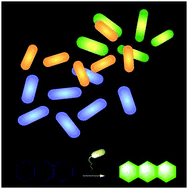Small-molecule fluorescent probes: big future for specific bacterial labeling and infection detection
Abstract
Bacterial infections remain a global healthcare problem that is particularly attributed to the spread of antibiotic resistance and the evolving pathogenicity. Accurate and swift approaches for infection diagnosis are urgently needed to facilitate antibiotic stewardship and effective medical treatment. Direct optical imaging for specific bacterial labeling and infection detection offers an attractive prospect of precisely monitoring the infectious disease status and therapeutic response in real time. This feature article focuses on the recent advances of small-molecule probes developed for fluorescent imaging of bacteria and infection, which covers the probe design, responsive mechanisms and representative applications. In addition, the perspective and challenges to advance small-molecule fluorescent probes in the field of rapid drug-resistant bacterial detection and clinical diagnosis of bacterial infections are discussed. We envision that the continuous advancement and clinical translations of such a technique will have a strong impact on future anti-infective medicine.

- This article is part of the themed collections: Multimolecular Crowding in Biosystems and ChemComm Community – Dedicated Authors


 Please wait while we load your content...
Please wait while we load your content...